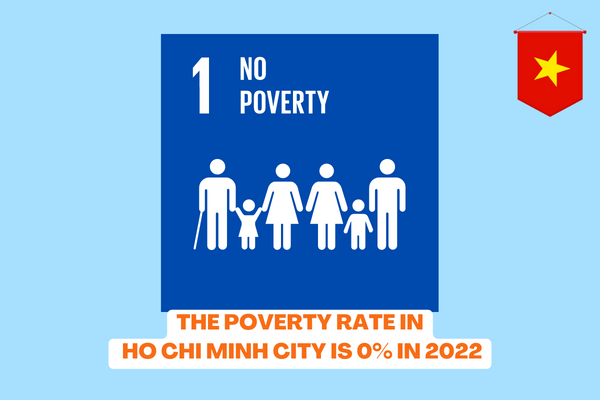Vietnam: The poverty rate in Ho Chi Minh City is 0% in 2022? What is the total number of poor and near-poor households nationwide?
Is the poverty rate in Ho Chi Minh City of Vietnam 0% in 2022?
On 19/01/2023, the Ministry of Labor, War Invalids and Social Affairs issued Decision 71/QD-LDTBXH in 2023 announcing the results of the review of poor and near-poor households in 2022 according to the multidimensional poverty line for the period 2022-2025.
Accordingly, based on Appendix I issued together with Decision 71/QD-LDTBXH in 2023 on the results of the review of poor and near-poor households in 2022 according to the multidimensional poverty line 2022 - 2025 nationwide.
Ho Chi Minh City and Ba Ria - Vung Tau are 02 areas without poor households and poor households with a multidimensional rate of 0%.
Download Appendix I issued together with Decision 71/QD-LDTBXH in 2023: Here.

Vietnam: The poverty rate in Ho Chi Minh City is 0% in 2022? What is the total number of poor and near-poor households nationwide?
What is the total number of poor and near-poor households nationwide in 2022 in Vietnam?
Based on the provisions of Point a, Clause 1, Article 1 of Decision 71/QD-LDTBXH in 2023, the total number of poor and near-poor households in 2022 is 1,972,767 households.
Specifically, the results of the review of near-poor households in 2022 are as follows:
(1) Multidimensional poverty rate (including the ratio of poor households and near-poor households):
- Nationwide: Multidimensional poverty rate is 7.52%; the total number of poor households and multidimensional near-poor households is 1,972,767 households.
- By regions:
+ Northern Midlands and Mountains: Multidimensional poverty rate is 21.92%; the total number of poor households and multidimensional near-poor households is 701,461 households.
+ Red River Delta: Multidimensional poverty rate is 2.45%; the total number of poor households and multidimensional near-poor households is 169,566 households.
+ North Central and Central Coast: Multidimensional poverty rate is 10.04%; the total number of poor households and multidimensional near-poor households is 571,251 households.
+ Central Highlands: Multidimensional poverty rate is 15.39%; the total number of poor households and multidimensional near-poor households is 236,766 households.
+ Southeast: Multidimensional poverty rate is 0.34%; the total number of poor households and multidimensional near-poor households is 15,787 households.
+ Mekong Delta: Multidimensional poverty rate is 5.73%; the total number of poor households and multidimensional near-poor households is 277,936 households.
(2) Poor households
- Nationwide: The poverty rate is 4.03%; the total number of poor households is 1,057,374 households.
- By region:
+ Northern Midlands and Mountainous areas: The poverty rate is 14.23%; the total number of poor households was 455,271.
+ Red River Delta: The poverty rate is 1.00%; the total number of poor households is 69,239 households.
+ North Central and Central Coast: The poverty rate is 4.99%; the total number of poor households was 284,137.
+ Central Highlands: The poverty rate is 8.39%; the total number of poor households was 129,160.
+ Southeast: The poverty rate is 0.21%; the total number of poor households was 9,710.
+ Mekong Delta: The poverty rate is 2.26%; the total number of poor households was 109,767.
(3) Near-poor households
- Nationwide: The rate of near-poor households is 3.49%; the total number of near-poor households was 915,274.
- By region:
+ Northern Midlands and Mountainous areas: The rate of near-poor households is 7.69%; the total number of near-poor households is 246,190 households.
+ Red River Delta: The rate of near-poor households is 1.45%; the total number of near-poor households is 100,237 households.
+ North Central and Central Coast: The rate of near-poor households is 5.05%; the total number of near-poor households was 287,114.
+ Central Highlands: The rate of near-poor households is 6.99%; the total number of near-poor households was 107,487.
+ Southeast: The rate of near-poor households is 0.13%; the total number of near-poor households was 6,077.
+ Mekong Delta: The rate of near-poor households is 3.46%; the total number of near-poor households is 168,169 households.
(4) Poor districts according to Decision 353/QD-TTg dated March 15, 2022 of the Prime Minister approving the list of poor districts, communes with special difficulties in horizontal, coastal and island areas in the period of 2021 - 2025:
- Multidimensional poverty rate is 55.45%; the total number of poor and near-poor households is 538,737 households.
- The poverty rate is 38.62%; the total number of poor households was 375,141.
- The rate of near-poor households is 16.84%; the total number of near-poor households was 163,596.
How are the criteria for measuring multidimensional poverty in the period of 2022 - 2025 regulated in Vietnam?
Pursuant to Clause 1 Article 3 of Decree 07/2021/ND-CP, the criteria for measuring multidimensional poverty in the period of 2022 - 2025 include:
- Income criteria
+ Rural areas: VND 1,500,000/person/month.
+ Urban area: 2,000,000 VND/person/month.
- Criteria for the lack of basic social services
+ Basic social services (06 services), including: employment; Health; education; housing; running water and sanitation; information.
+ Indicators measuring the lack of basic social services (12 indicators), including: employment; dependents in the household; nutritious; health insurance; the level of education of adults; children's school attendance; quality of housing; housing area per capita; domestic water sources; hygienic latrines; use of telecommunications services; means of access to information.
- Basic social services, an index measuring the level of shortage of basic social services and the threshold of deficiency
LawNet
